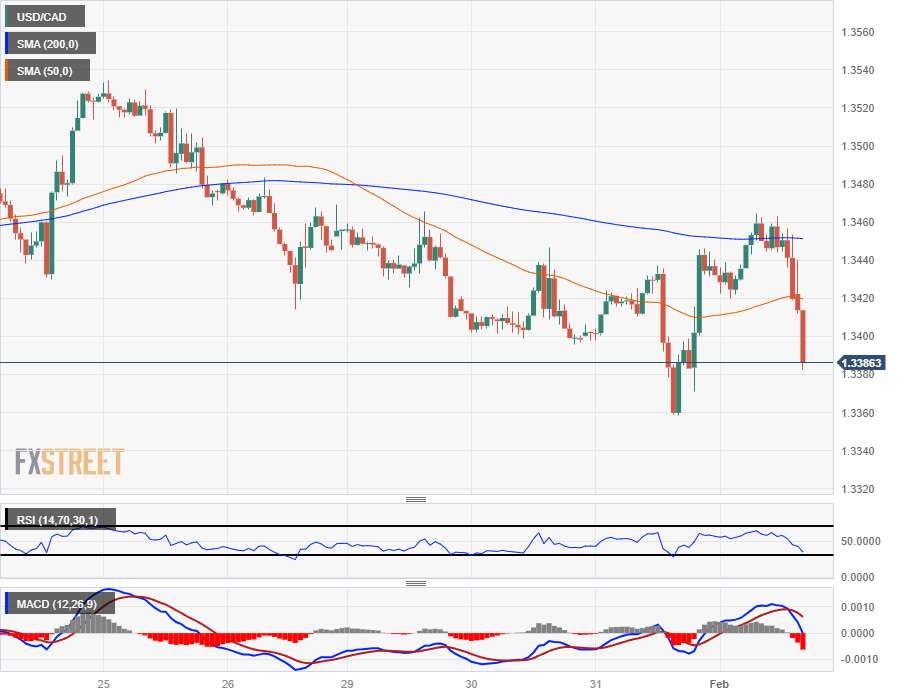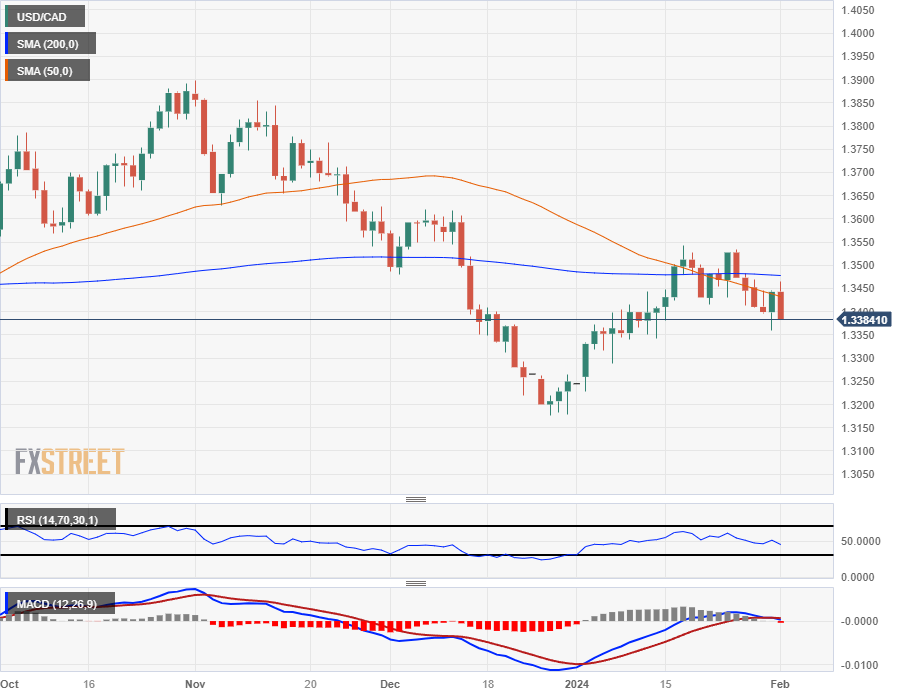- The Canadian dollar remained mixed during trading on Thursday, while crude oil plunged.
- Canada recorded an improvement in January manufacturing PMIs.
- Markets are bracing for another US NFP on Friday.
He Canadian dollar (CAD) It is trading mixed against a basket of major currencies, but advancing against the US Dollar (USD). Markets are settling after Wednesday's departure from the Federal Reserve (Fed) that saw Fed Chair Jerome Powell strike a much tougher tone than many investors expected. This sent equity markets tumbling and fueled risk-averse flows into the safe-haven Dollar.
Canada recorded a rebound in the S&P Global manufacturing Purchasing Managers' Index (PMI) for January, but the manufacturing confidence indicator remains in contractionary territory, below 50.0 points. The US ISM Manufacturing PMI also beat expectations, but remains below 50.0 points. Initial jobless claims in the US unexpectedly rose, rising above the four-week average for jobless claimants.
Daily Market Summary: Canadian Dollar Regains Ground Against US Dollar
- The Canadian Manufacturing PMI stood at 48.3 in January, up from 45.4 the previous month, marking a strong recovery from the three-and-a-half-year low recorded in December.
- Initial claims for unemployment benefits in the US for the week ending January 26 stood at 224,000, compared to the 212,000 expected. Last week, unemployment claims were 215,000.
- Initial jobless claims hit their highest level since Nov. 10, surpassing the four-week average of 207,750.
- The US ISM Manufacturing PMI recovered to 49.1 points in January, compared to the expected decline to 47.0 points from 47.1 in December, its highest reading in 16 months.
- US ISM manufacturing paid prices also rose to a 9-month high of 52.9 compared to the expected jump to 46.9 from 45.2 in December as producer-level inflation eases.
- The week will close on Friday with another data of great impact: the US non-farm payrolls (NFP).
- According to forecasts, the number of jobs created by the NFP will fall to 180,000 in January, compared to 216,000 in December.
- NFP forecast figures have been lower than the actual NFP print in all but four of the last 21 consecutive releases.
- Crude oil markets have flattened after a panic rally that saw US West Texas Intermediate (WTI) crude oil rise over $79 per barrel last week.
- Crude oil bids have pulled back, allowing WTI to settle just above $76.
Quote of the Canadian Dollar today
The following table shows the percentage change of the Canadian Dollar (CAD) against the currencies listed today. The Canadian dollar was the strongest currency against the US dollar.
| USD | EUR | GBP | CAD | AUD | JPY | NZD | CHF | |
| USD | -0.57% | -0.37% | -0.41% | -0.10% | -0.61% | -0.38% | -0.56% | |
| EUR | 0.57% | 0.20% | 0.14% | 0.49% | 0.00% | 0.19% | 0.01% | |
| GBP | 0.38% | -0.19% | -0.06% | 0.32% | -0.19% | -0.01% | -0.19% | |
| CAD | 0.39% | -0.16% | 0.06% | 0.33% | -0.14% | 0.06% | -0.13% | |
| AUD | 0.10% | -0.49% | -0.31% | -0.35% | -0.49% | -0.27% | -0.45% | |
| JPY | 0.58% | 0.00% | 0.19% | 0.14% | 0.46% | 0.14% | 0.02% | |
| NZD | 0.38% | -0.17% | 0.02% | -0.02% | 0.29% | -0.22% | -0.17% | |
| CHF | 0.55% | -0.02% | 0.19% | 0.10% | 0.46% | -0.05% | 0.16% |
The heat map shows the percentage changes of the major currencies against each other. The base currency is chosen in the left column, while the quote currency is chosen in the top row. For example, if you choose the euro in the left column and scroll down the horizontal line to the Japanese yen, the percentage change in the box will represent EUR (base)/JPY (quote).
Technical Analysis: Canadian Dollar Recovers Against US Dollar, Mixed in Europe and Oceania
The Canadian Dollar (CAD) rallied a quarter of a percentage point against the US Dollar on Thursday, but gave up about a quarter of a percentage point against the Japanese Yen (JPY), the best performing currency of the day. The Canadian Dollar fell slightly against the Euro (EUR) and Swiss Franc (CHF) as market activity focused on other currencies, but rose by around a third against the Australian Dollar (AUD).
The USD/CAD pair fell back below the 1.3400 zone for the fourth time in two days, while the GBP/USD pair falters on market sentiment. The pair recovered to 1.3460 early Thursday, following Wednesday's Fed-fueled turmoil, reaching a near-term low of 1.3360.
The USD/CAD pair is heading back into the bearish zone, near 1.3380, with Thursday's high marking a rejection of the 200-hour SMA. Thursday's bullish momentum takes USD/CAD towards the lower end of the short-term congestion that has plagued the pair on daily candlestick charts. Intraday, the stock will remain capped by the 200-day SMA just below the 1.3500 area.
USD/CAD hourly chart

USD/CAD daily chart
economic indicator
United States Nonfarm Payrolls
Non-Farm Payroll Release presents the number of new jobs created in the US during the previous month in all non-farm businesses, it is published by the US Bureau of Labor Statistics (BLS). The monthly evolution of payrolls can be extremely volatile. The figure is also subject to strong revisions, which can also trigger volatility on the currency board. Generally, a high reading is considered bullish for the US Dollar (USD), while a low reading is considered bearish, although revisions from previous months and the Unemployment Rate are as relevant as the headline figure. The market reaction, therefore, depends on how the market values all the data contained in the BLS report as a whole.
More information.
Next Publication: 02/02/2024 13:30:00 GMT
Periodicity: Monthly
Fountain: US Bureau of Labor Statistics
Why it is important for operators
The monthly US employment report is considered the most important economic indicator for currency traders. Published on the first Friday of the month, the variation in the number of positions is closely correlated with the general evolution of the economy and is monitored by policy makers. Full employment is one of the mandates of the Federal Reserve, which takes into account the evolution of the labor market when setting its policies, which has an impact on currencies. Although several leading indicators shape estimates, nonfarm payrolls often surprise markets and trigger high volatility. Actual numbers that exceed consensus tend to be bullish for the dollar.
Frequently Asked Questions about the Canadian Dollar
What factors determine the price of the Canadian dollar?
The key factors that determine the price of the Canadian dollar (CAD) are the level of interest rates set by the Bank of Canada (BoC), the price of oil, Canada's main export product, the health of its economy, inflation and the trade balance, which is the difference between the value of Canadian exports and its imports. Other factors are market confidence, that is, whether investors bet on riskier assets (risk-on) or look for safe assets (risk-off), with the risk-on being positive for the CAD. As its largest trading partner, the health of the US economy is also a key factor influencing the Canadian dollar.
How do Bank of Canada decisions affect the Canadian dollar?
The Bank of Canada (BoC) exerts significant influence over the Canadian Dollar by setting the level of interest rates that banks can lend to each other. This influences the level of interest rates for everyone. The BoC's main objective is to keep inflation between 1% and 3% by adjusting interest rates up or down. Relatively high interest rates are usually positive for the CAD. The Bank of Canada can also use quantitative easing and tightening to influence credit conditions, with the former being negative for the CAD and the latter being positive for the CAD.
How does the price of oil affect the Canadian dollar?
The price of oil is a key factor influencing the value of the Canadian Dollar. Oil is Canada's largest export, so the price of oil tends to have an immediate impact on the value of the CAD. Generally, if the price of oil rises, the CAD also rises, as aggregate demand for the currency increases. The opposite occurs if the price of oil falls. Higher oil prices also tend to lead to a higher probability of a positive trade balance, which also supports the CAD.
How does inflation data influence the value of the Canadian Dollar?
Although inflation has traditionally always been considered a negative factor for a currency, as it reduces the value of money, the opposite has actually happened in modern times, with the relaxation of cross-border capital controls. Higher inflation often leads central banks to raise interest rates, attracting more capital inflows from global investors looking for a lucrative place to store their money. This increases the demand for the local currency, which in the case of Canada is the Canadian Dollar.
How does economic data influence the value of the Canadian dollar?
The published macroeconomic data measures the health of the economy and may have an impact on the Canadian dollar. Indicators such as GDP, manufacturing and services PMIs, employment and consumer confidence surveys can influence the direction of the CAD. A strong economy is good for the Canadian dollar. Not only does it attract more foreign investment, but it may encourage the Bank of Canada to raise interest rates, resulting in a stronger currency. However, if economic data is weak, the CAD is likely to fall.
Source: Fx Street
I am Joshua Winder, a senior-level journalist and editor at World Stock Market. I specialize in covering news related to the stock market and economic trends. With more than 8 years of experience in this field, I have become an expert in financial reporting.







